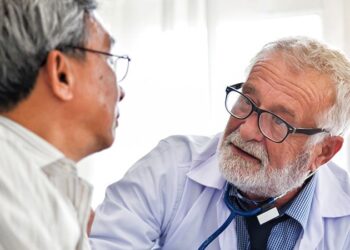The American College of Physicians (ACP) strongly recommends adding a triptan to a nonsteroidal anti-inflammatory drug (NSAID) to treat nonpregnant and nonlactating adults with moderate to severe acute episodic migraine when an NSAID alone is ineffective. ACP also conditionally recommends adding a triptan to acetaminophen for adults when the latter alone is ineffective.
Migraine is a disabling condition, ranking as the second leading cause of global disability in all adults. In the United States, migraine affects about 16% of people, with higher prevalence in women (21%) than men (11%).
The guideline is based on a systematic review and network meta-analysis of the benefits and harms of pharmacologic treatments for acute episodic migraine headaches (defined as 1-14 headache days per month) as well as reviews of patient preferences and cost-effectiveness analyses. About 21 head-to-head and 165 placebo-controlled trials were included in the analyses.
Evidence showed that triptans combined with NSAIDs were more effective in achieving pain freedom or pain relief at 2 hours, pain freedom up to 48 hours, and less need for rescue medication compared with acetaminophen, gepants, NSAIDs, and triptan monotherapy.
The Clinical Guidelines Committee, led by the ACP’s Amir Qaseem, MD, PhD, MHA, determined that triptans, NSAIDs (aspirin, celecoxib, diclofenac, ibuprofen, and naproxen), acetaminophen, and the combination of a triptan with an NSAID or acetaminophen were effective for treating acute moderate to severe episodic migraine compared with placebo.
Comparative effectiveness evidence demonstrated that combining a triptan (sumatriptan) and an NSAID (naproxen) had the greatest net benefit, with a larger net benefit than with a triptan, an NSAID, acetaminophen, or a calcitonin gene–related peptide (CGRP) antagonist gepant alone.
Patient Preferences Considered
Along with the systematic review and meta-analysis of pharmacologic treatments, ACP conducted a rapid review of 17 studies with 6568 patients on patients’ values and preferences for treatments.
Kylie Thaler, MD, MPH, with Cochrane Austria, the ACP Center for Evidence Reviews, and the University for Continuing Education Krems in Krems, Austria, and colleagues found that pain effectiveness was the top consideration for patients. Avoiding harms was more important to them than other considerations of migraine treatment, such as route of administration.
As for particular symptoms, patients deemed “relieving nausea with or without vomiting as more important than relieving photophobia, problems with vision, or tiredness and irritability.” Oral medications were preferred to other routes of administration.
Comparison of Adverse Events Between Triptans and Other Treatments
The committee determined that triptans are linked with more toxicities than NSAIDs and acetaminophen. Although these adverse events are generally mild (nausea, dizziness, and fatigue), the members wrote, “[I]t is important to consider that they could still affect daily activities and quality of life in some people.”
In an accompanying editorial, Marianna Shnayderman Yugrakh, MD, with the Headache Program, Department of Neurology, Columbia University Irving Medical Center in New York City, noted that the ACP recognizes that acute treatment may involve a step-care model. First, patients may try increasing the dose of a simple analgesic to a higher recommended dose. Next may come the combination therapy of a triptan and an NSAID or acetaminophen. If a treatment is ineffective, another drug in the same class may work.
If a triptan and NSAID/acetaminophen are not effective or not tolerated, “a gepant or dihydroergotamine may be considered, followed by lasmiditan as the next step,” Yugrakh wrote.
“The ACP recommendations, for the most part, align with the 2024 International Headache Society (IHS) recommendations for acute migraine treatment with a key exception: The IHS recommends triptan monotherapy if a simple analgesic is insufficient, with subsequent optimization of triptan dose and route of administration and then trials of three different triptans before a trial of sumatriptan with naproxen or addition of another NSAID,” she wrote.
Consider Individual Needs as Well
Yugrakh advised thinking beyond the guidelines to achieve what works for individual patients.
For example, she says, “[P]atients with attacks with vomiting should be offered subcutaneous or intranasal formulations of triptans (sumatriptan or zolmitriptan) in addition to antiemetics.”
Additionally, comorbidities such as uncontrolled cardiovascular disease or peptic ulcer disease should trigger avoidance of triptans and dihydroergotamine or NSAIDs, she noted.
The committee adds other advice for clinicians when talking to patients, including:
- Counseling patients to start treating a migraine as soon as possible after its onset.
- Highlighting the importance of lifestyle modifications, including staying well hydrated, eating regular meals, getting consistent sleep, and engaging in regular physical activity.
The committee deemed differences in costs between the combinations of a triptan with an NSAID or acetaminophen and triptan monotherapy were negligible (all had annualized wholesale costs of about $500). However, combining a triptan with an NSAID or acetaminophen was less expensive than other treatments, particularly the CGRP antagonists gepants ($5994) and lasmiditan ($6668).
Financial disclosures are available with the full texts of the papers.
Source link : https://www.medscape.com/viewarticle/two-key-recommendations-outpatient-treatment-acute-migraine-2025a10006iv?src=rss
Author :
Publish date : 2025-03-19 07:21:00
Copyright for syndicated content belongs to the linked Source.














